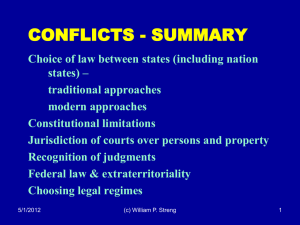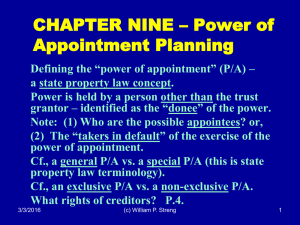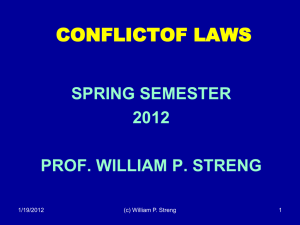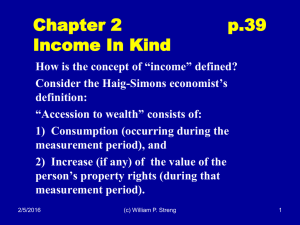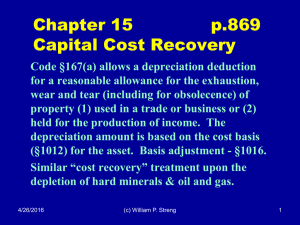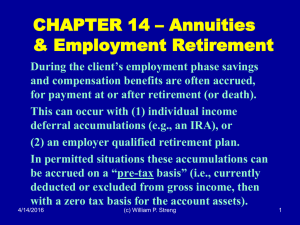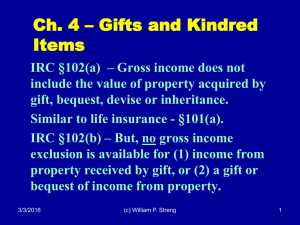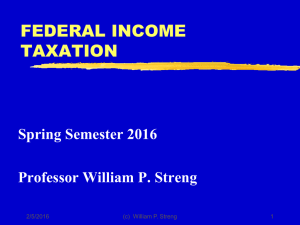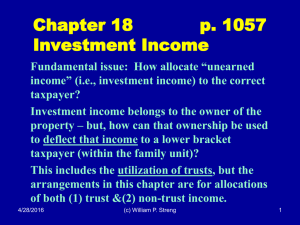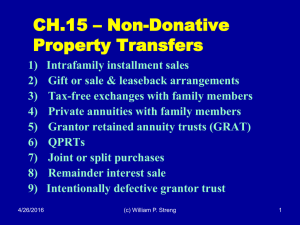CHAPTER SIX – Income Tax – Non-grantor Trusts
advertisement
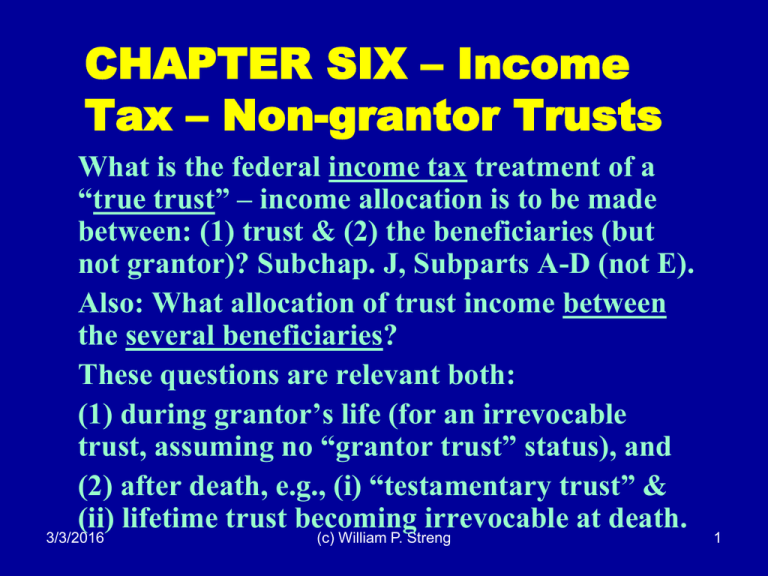
CHAPTER SIX – Income Tax – Non-grantor Trusts What is the federal income tax treatment of a “true trust” – income allocation is to be made between: (1) trust & (2) the beneficiaries (but not grantor)? Subchap. J, Subparts A-D (not E). Also: What allocation of trust income between the several beneficiaries? These questions are relevant both: (1) during grantor’s life (for an irrevocable trust, assuming no “grantor trust” status), and (2) after death, e.g., (i) “testamentary trust” & (ii) lifetime trust becoming irrevocable at death. 3/3/2016 (c) William P. Streng 1 Remembering the Trust Distribution Options P.3 1) 2) 3) 4) 5) Distribute income currently Accumulate trust income Ascertainable standard (HSEM) Trustee’s total discretion Spray or sprinkle power to multiple beneficiaries (or only to one beneficiary & not the other). Query in this chapter: What relevance of these options for federal income tax purposes? 3/3/2016 (c) William P. Streng 2 Trust Income Tax Code Statutory Rules Subchapter J (Code §§ 641-679) Subpart A - General rules, including the “distributable net income” or “DNI” definition. Subpart B – Simple trusts – distribute all income. Subpart C - Complex trusts - flexibility Subpart D – Accumulation trusts (“throwback rules’’) Subpart E – Grantor trust rules 3/3/2016 (c) William P. Streng 3 Considering the Trust Income Tax Rates p.5 Maximum 39.6% rate reached at very low level for trust - $12,400 in 2016. Code §1(e). Consider the following options: (1) Tax incentive to distribute income. (2) Investment policy for having “unrealized” gains (e.g., capital gain assets). (3) Incentive for flexible structuring of the trust instrument to provide for the discretionary distribution of trust income to the tax appropriate beneficiaries. 3/3/2016 (c) William P. Streng 4 When Does Trust’s P.6 Existence Commence? (1) Intervivos trust – existence commences when irrevocable and funded. (2) Testamentary trust – when funded from the probate estate (and other sources). Note Code §645 (previously §646) re possible combination of the estate and a “qualified revocable trust” as being one taxpayer for federal income tax purposes. 3/3/2016 (c) William P. Streng 5 Defining Distributable net Income (“DNI”) P.7 See the definition of “DNI” in Code §643(a). What is the purpose of the DNI concept? Note “income” differences for trusts between: (1) trust law accounting, and (2) income tax accounting. Consider (examples, p. 11): (1) Relevance of capital gains and losses (i.e., income or corpus?); income tax at the trust level (and not to the beneficiary)? (2) A “total return” investment policy. (3) Treatment of trust administration expenses. 3/3/2016 (c) William P. Streng 6 Simple Trust Tax p.12 Treatment - §§651-652 Example: All income is currently distributable. Pertinent income tax rules: §651 - deduction to the trust for the amount required to be distributed. §652(a) - income inclusion required of the beneficiary for the amount required to be distributed; but, even if not distributed? §652(b) – tax character of income items is retained into the hands of the beneficiary (e.g., tax-exempt bond income). 3/3/2016 (c) William P. Streng 7 “Complex Trust” Tax §§661-664 p.13 §661(a) – a deduction to a trust for amounts: 1) required to be distributed, and 2) actually distributed. §662(a) - income inclusion required of the beneficiary for an income amount: 1) required to be distributed (even if not distributed), and 2) actually distributed. §662(b) – character of income items is retained into the hands of the beneficiary. 3/3/2016 (c) William P. Streng 8 Multiple Tier Distributions – Complex Trust p.14 1st tier beneficiary – receives an amount required to be distributed. 2nd tier beneficiary – receives discretionary distributions (after mandatory distributions). Allocation of DNI first to the 1st tier beneficiary. Planning: How direct the 1st tier distributions? What if the financial circumstances of some beneficiaries change subsequent to the trust funding? 3/3/2016 (c) William P. Streng 9 Separate Share Rule §663(c) p.15 Each trust is created under one trust agreement but is treated as a separate trust for Subchapter J income allocation rules. What is the income tax objective of this “separate share” rule? What if the trust has a “spray or sprinkle” power? Is the separate trust rule applicable? Priv. Ltr. Rul. 9321055 – p. 16. 3/3/2016 (c) William P. Streng 10 Income Distributions Made “In Kind” p.19 The interrelated income tax elements are: (1) built-in gain (loss) in the distributed property, and (2) the DNI distribution rules. See Code §643(e) – eliminates the potential to make accrued capital gain disappear from the tax base on a property distribution from trust. However, can make election to recognize gain. What is the purpose of this §643(e)(3) election to recognize gain on the distribution? 3/3/2016 (c) William P. Streng 11 Estate Distributions of Specific Bequests p.23 §663(a)(1) – exception from the DNI rules for the estate distribution of specific bequests. What is a “specific bequest” for this purpose? Why enable this exception? Assets have a stepped-up basis for income tax. Note §102 re exclusion of bequest from gross income of recipient. PLR 9218076 – p. 23 – will contest/dispute and compromise distributions. Not §663(a)(1). 3/3/2016 (c) William P. Streng 12 Trust Throwback Rules p.25 §§665-668 - accumulation trust rules. Now domestic trusts are exempt from these rules. What is the reason for this exemption? Income tax rate bracket structure; i.e., no incentive to accumulate under the present income tax rate structure. Throwback rules are applicable to foreign trusts. Why? 3/3/2016 (c) William P. Streng 13 Limitation on Multiple Trusts p.27 §§643(f) and 667(c) – objective of these rules? To limit attempts for “multiple runs up the [§1(e)]bracket ladder.” Particularly when considering the low level of the highest trust income tax bracket. 3/3/2016 (c) William P. Streng 14 WWWWW wwww 3/3/2016 (c) William P. Streng 15

